November 6, 2012
Global Youth See Reconstruction Efforts Firsthand after 2011 Japan Earthquake -- Transforming What Survivors Learned into Lessons for the World
Keywords: Newsletter
JFS Newsletter No.122 (October 2012)
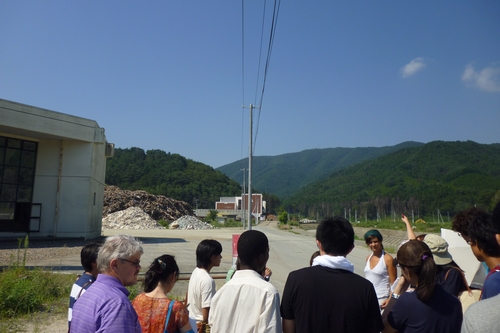
Japan for Sustainability (JFS) organized the "Learning Journey in Tohoku" from August 20 to August 25 in 2012 for students, from both Japan and other parts of the world, to meet and interview people who survived the 2011 Great East Japan Earthquake disaster. These are people striving to restore and rebuild their lives in the disaster-affected area. The students' journey allowed them to follow the survivors' experiences after March 11, 2011, and to get a closer, deeper, look at the reality of their situation.
Why Did JFS Host the Learning Journey?
The earthquake brought devastating damages to Japan, especially in the Tohoku Region. One-and-a-half years afterwards, all-out efforts for recovery and rebuilding are underway across the disaster area, but it is true that the real recovery of the region will take a long time.
We face many social problems in the world, including global warming and aggravated poverty issues, but against this backdrop the question is how can we build a sustainable society that is affluent in the true sense? In Tohoku, where people are moving on toward rebuilding, despite the complicated and difficult situation, there seems to be many lessons that people, both from Tohoku and other parts of the world, can learn.
In order to continue the efforts to rebuild and create a more sustainable society, which will take many years, it is important to keep on sending out the message about current conditions in Tohoku to allow the world to learn from it.
For that reason, young people from around the world, potential leaders of the next generation, visited the disaster-affected area, and then communicated about what they had learned, the changes that occurred in themselves, and crafted their messages for the world. The Learning Journey was organized to cultivate the sensitivities and capabilities of these young people, as well as to share what people in Tohoku have to teach the world.
Learning Process
The 14 participants of the Learning Journey came from all over the world -- from Canada, Korea, Zimbabwe, China, Denmark, Germany, Finland, Brazil, and Japan -- with diverse backgrounds in terms of culture, expertise, and experience.
Three locations in Tohoku -- Ishinomaki, Ogatsu, and Kesennuma in Miyagi Prefecture -- were selected for them to visit, during which it was arranged for them to meet as many local residents, businesses, governments, and recovery-related non-profit organizations as possible, allowing them to experience the diverse aspects of the disaster and recovery efforts.
Another feature of the journey was having participants with different points of view so they could learn about diverse realities and deepen their understanding together through dialogue. Therefore, facilitators Dr. Bob Stilger and Ms. Mikako Yusa, who have much experience in organizational learning, accompanied the students on their journey.
Preparing for the Learning Journey
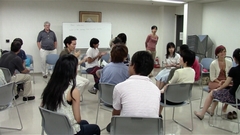
Before the visit to Tohoku, the first session was held in Tokyo, where participants were asked to think about some questions. The first was "What is the journey that brought you here?" Responses from the participants were: "I want to hear the story from the people in Tohoku directly"; "I want to take action for the people in Tohoku, not just to learn from them"; "I want to create an opportunity for people to look at Tohoku again"; and "I want to think about a sustainable society with people from around the world."
After that, they thought about the following questions: "When we end this journey, how would you/the group/the people you will meet like to be? What will the feeling be like?" The participants said, "I want to feel connected to Tohoku," "I want to have deeper senses to think of and respect for others," and "I hope we can be a family."
The Learning Journey in Tohoku
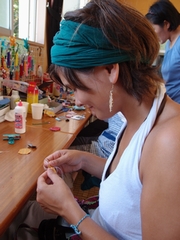
In Tohoku, the participants met and interviewed those who survived the disaster and are still struggling to restore their lives. One of the groups they met was the "Funakoshi Ladies" in the Funakoshi area of Ogatsu Town in Miyagi Prefecture, a group set up by women in the area who survived the earthquake.
They make and sell accessories, such as pendants and key chains, featuring a type of stone called "Ogatsu-ishi" (Ogatsu stone) that the town is famous for, where it is used for ink stone and roof slates in the area, which they salvaged from the earthquake debris. In doing so, they are making a living and working for the reconstruction of the community.
The Funakoshi area is no exception of the outflow of population that happened in Ogatsu. Before the earthquake, 120 households lived in the area, but now only one of them remains after the drastic population decrease. Most members of the Funakoshi Ladies live in temporary housing in Ishinomaki City, one hour's drive from the area. One of them told the students, "Even so, I can't wait to meet friends in the community."
Most of the journey participants were impressed with the women, because of how they warmly and cheerfully welcomed volunteers and visitors -- not to mention that they have had hard experiences and struggles. One of the ladies said, "We were not as we are now. The earthquake was too hard for me to cry for a long time. I just felt very depressed. But at some point, I was able to cry, and after that, various feelings inside me started to go out suddenly. If I had been alone, I don't know what I would have done. But it is the friends in this community who have been with me, and thus I can spend every day happily with smiles."
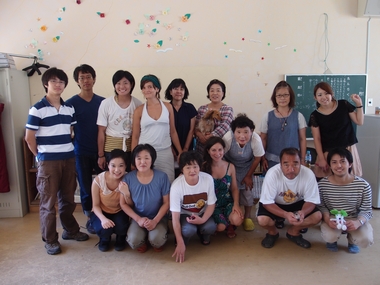
Besides the Funakoshi Ladies, the journey group met various people and had various experiences in Tohoku. Some told about their trying, tearful, and sad experiences when the earthquake hit, while others explained their strong motivation to reconstruct their hometown into a better place, the complex reality that hinders it, and many the smiles and amounts of energy along the way. All of these are the reality in Tohoku. Based on these experiences, the 14 participants of the Learning Journey had many dialogues and deepened their understanding.
Holding the Dialogue Event
On the last day of the Learning Journey, August 25, the project held a dialogue event, "From Tohoku to the World: What We Can Tell," which was designed by the participants, who also acted as dialogue hosts and facilitators at the event.
By sharing their experiences with the people who attended the event, they had deep dialogues about what we can learn from people in the earthquake affected area, what we should learn from them, and about the themes such as rebuilding social and economic systems and sustainability which are necessary for us all to survive.
The dialogue event became a concrete action to work on our society, and we can see it as one of the most significant results of the Learning Journey.
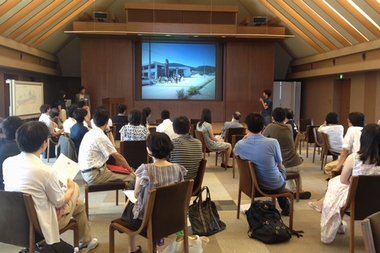
Comments from Participants
After the Learning Journey, we received reflections from the participants. The followings are excerpts of some of these (some edited).
- I want to relay a baton to people close to me, passing on the opportunity I got, lessons learned, and the gratefulness I felt through the Learning Journey. I want to have responsibility and awareness to the society and community I belong to, start doing what I can do, and communicate these things to people around me.
- I realized how "ordinary" the life I live is and how thankful I should be. I could recall what is really important: gratefulness.
- What I can do and what I should do is to keep telling about it. I feel my role is to continue sharing all the experiences I had -what I saw, heard, and felt -as well as the thoughts of the friends I learned together with. I hope that such communication will be like planting seeds for the future, and that many people will remember my story and take action when something happens.
- I strongly felt the Great East Japan Earthquake is not an event that happened at a time in the past but the one that we should keep thinking about from now on, and that we should never forget.
- I realized the reality is different from what I watch on television, and that the Great East Japan Earthquake is what I should face and what I am involved with.
- Up to now, I had felt the Great East Japan Earthquake was something far away from me and I couldn't take any action. Getting to know the local people who are working hard on the recovery, though, I was encouraged very much and decided to do to the utmost of what I can do. I would like to visit the disaster-affected area once again some day and start doing what I can do and take action.
Closing
"When are you coming back? Please come again!" I still remember clearly what members of the Funakoshi Ladies said when we left. We saw many scenes where the participants and local people made deep connections, not just like a relationship between visitors from outside and receivers of local people but as real person-to-person communication. Two months after the Learning Journey, some of the participants already started taking concrete actions for the recovery of the Tohoku Region and the creation of a sustainable society. We can't wait to see how the young people who participated in the Learning Journey will put what they have learned from it into action.
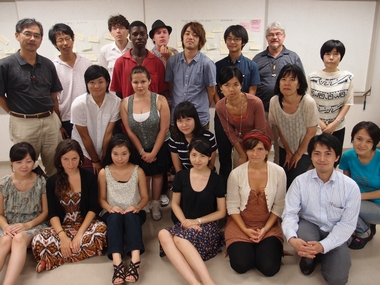
Written by Takuya Goto
Learning Journey in Tohoku Website
http://www.japanfs.org/tohoku/en/journey/
* Videos and articles of the Learning Journey Report will be posted from time to time.
Related
"JFS Newsletter"
- 'Good Companies in Japan' (Article No.4): 'Eightfold Satisfaction' Management for Everyone's Happiness
- "Nai-Mono-Wa-Nai": Ama Town's Concept of Sufficiency and Message to the World
- 'Yumekaze' Wind Turbine Project Connects Metro Consumers and Regional Producers: Seikatsu Club Consumers' Co-operative
- Shaping Japan's Energy toward 2050 Participating in the Round Table for Studying Energy Situations
- 'Good Companies in Japan' (Article No.3): Seeking Ways to Develop Societal Contribution along with Core Businesses


